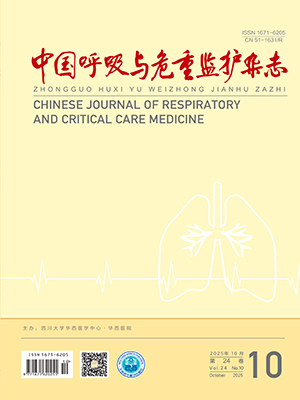| 1. |
Manzanares W, Hardy G. Thiamine supplementation in the critically ill. Curr Opin Clin Nutr Metab Care, 2011, 14(6): 610-617.
|
| 2. |
Sriram K, Manzanares W, Joseph K. Thiamine in nutrition therapy. Nutr Clin Pract, 2012, 27(1): 41-50.
|
| 3. |
Mallat J, Lemyze M, Thevenin D. Do not forget to give thiamine to your septic shock patient! J Thorac Dis, 2016, 8(6): 1062-1066.
|
| 4. |
Jamieson CP, Obeid OA, Powell-Tuck J. The thiamin, riboflavin and pyridoxine status of patients on emergency admission to hospital. Clin Nutr, 1999, 18(2): 87-91.
|
| 5. |
Cruickshank AM, Telfer AB, Shenkin A. Thiamine deficiency in the critically ill. Intensive Care Med, 1988, 14(4): 384-387.
|
| 6. |
Lima LF, Leite HP, Taddei JA. Low blood thiamine concentrations in children upon admission to the intensive care unit: risk factors and prognostic significance. Am J Clin Nutr, 2011, 93(1): 57-61.
|
| 7. |
Costa NA, Gut AL, de Souza Dorna M, et al. Serum thiamine concentration and oxidative stress as predictors of mortality in patients with septic shock. J Crit Care, 2014, 29(2): 249-252.
|
| 8. |
Donnino MW, Carney E, Cocchi MN, et al. Thiamine deficiency in critically ill patients with sepsis. J Crit Care, 2010, 25(4): 576-581.
|
| 9. |
Donnino MW, Andersen LW, Chase M, et al. Randomized, double-blind, placebo-controlled trial of thiamine as a metabolic resuscitator in septic shock: a pilot study. Crit Care Med, 2016, 44(2): 360-367.
|
| 10. |
中国医师协会急诊医师分会, 中国研究型医院学会休克与脓毒症专业委员会. 中国脓毒症/脓毒性休克急诊治疗指南(2018). 感染、炎症、修复, 2019, 20(1): 3-22.
|
| 11. |
Singer M, Deutschman CS, Seymour CW, et al. The Third International Consensus Definitions for Sepsis and Septic Shock (Sepsis-3). JAMA, 2016, 315(8): 801-810.
|
| 12. |
Shankar-Hari M, Phillips GS, Levy ML, et al. Developing a New Definition and Assessing New Clinical Criteria for Septic Shock: For the Third International Consensus Definitions for Sepsis and Septic Shock (Sepsis-3). JAMA, 2016, 315(8): 775-787.
|
| 13. |
Quest Diagnostics. Micronutrient, Vitamin B1 (Thiamine), Blood[EB/OL]. (2019)[2023-09-14]. https://testdirectory.questdiagnostics.com/.
|
| 14. |
Corcoran TB, O'neill MA, Webb SA, et al. Prevalence of vitamin deficiencies on admission: relationship to hospital mortality in critically ill patients. Anaesth Intensive Care, 2009, 37(2): 254-260.
|
| 15. |
Garcia-Alvarez M, Marik P, Bellomo R. Sepsis-associated hyperlactatemia. Crit Care, 2014, 18(5): 503.
|
| 16. |
Iglesias J, Vassallo AV, Patel VV, et al. Outcomes of metabolic resuscitation using ascorbic acid, thiamine, and glucocorticoids in the early treatment of sepsis: The ORANGES Trial. Chest, 2020, 158(1): 164-173.
|
| 17. |
Coloretti I, Biagioni E, Venturelli S, et al. Adjunctive therapy with vitamin c and thiamine in patients treated with steroids for refractory septic shock: a propensity matched before-after, case-control study. J Crit Care, 2020, 59: 37-41.
|
| 18. |
Marik PE, Khangoora V, Rivera R, et al. Hydrocortisone, citamin C, and thiamine for the treatment of severe sepsis and septic shock: a retrospective before-after study. Chest, 2017, 151(6): 1229-1238.
|
| 19. |
刘琼, 王金荣, 崔朝勃. 氢化可的松、维生素C和维生素B1联合治疗脓毒症研究进展. 中国呼吸与危重监护杂志, 2021, 20(5): 366-371.
|
| 20. |
桑珍珍, 王淑娟, 王伟, 等. 氢化可的松联合维生素C和维生素B1治疗老年感染性休克的临床疗效. 中国老年学杂志, 2020, 40(20): 4351-4354.
|
| 21. |
Suetrong B, Walley KR. Lactic acidosis in sepsis: it's not all anaerobic. Implications for diagnosis and management. Chest, 2016, 149(1): 252-261.
|
| 22. |
Donnino MW, Vega J, Miller J, et al. Myths and misconceptions of Wernicke's encephalopathy: what every emergency physician should know. Ann Emerg Med, 2007, 50(6): 715-721.
|
| 23. |
Singer P, Berger MM, Van Den Berghe G, et al. ESPEN Guidelines on Parenteral Nutrition: intensive care. Clin Nutr, 2009, 28(4): 387-400.
|
| 24. |
Nixon PF, Diefenbach RJ, Duggleby RG. Inhibition of transketolase and pyruvate decarboxylase by omeprazole. Biochem Pharmacol, 1992, 44(1): 177-179.
|




